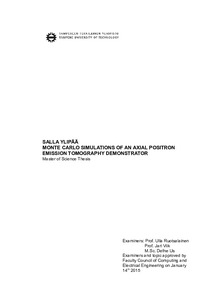Monte Carlo simulations of an axial positron emission tomography demonstrator
Ylipää, Salla (2015)
Ylipää, Salla
2015
Sähkötekniikan koulutusohjelma
Tieto- ja sähkötekniikan tiedekunta - Faculty of Computing and Electrical Engineering
This publication is copyrighted. You may download, display and print it for Your own personal use. Commercial use is prohibited.
Hyväksymispäivämäärä
2015-04-08
Julkaisun pysyvä osoite on
https://urn.fi/URN:NBN:fi:tty-201503231143
https://urn.fi/URN:NBN:fi:tty-201503231143
Tiivistelmä
Axial positron emission tomography (PET) scanners are composed of layers of scintillating crystals aligned with the main axis of the scanner. The axial coordinates of photon interaction events are obtained using a matrix of wavelength shifting strips placed orthogonally to the crystals. This construction allows acquiring depth of interaction information of the events, which removes the parallax error enabling simultaneous improvement of the scanners' sensitivity and spatial resolution.
In this thesis a computer model of the axial PET demonstrator called AvanTomography was built using GATE simulation toolkit. The model is based on the real demonstrator that is being constructed at Tampere University of Technology; the purpose of the model is to help in designing the demonstrator by enabling easy testing and characterisation using Monte Carlo simulations. This thesis describes the construction and validation of the model, and the initial results of performance testing.
The model includes the demonstrator's modular structure with scintillating crystals and wavelength shifting strips, signal read out and processing electronics. The axial coordinates of events are determined by simulating event positioning with the strips. As GATE does not currently support such novel event positioning, a new processing module was written into GATE source code as part of this thesis work. This new module simulates analytically the transport and distribution of scintillation photons in the scintillating crystals and wavelength shifting strips, and processes the signals in order to determine the axial coordinate of the events. In addition, the module handles pulse adding and discretisation of event radial and tangential coordinates.
The built model was then used to run simulations to study the model and the demonstrator system. Firstly, the model was validated for produced energy spectra, event rates, and axial coordinate determination. Scanner constructions having 2, 4 and 8 modules were tested for sensitivity, as well as the increase of sensitivity when radial layers of modules are added. Then scatter fraction and noise equivalent count rate were simulated using a rat sized phantom. The results show that the model can be used in simulating the functionality of an axial PET scanner, and could in future be used to determine the performance, including spatial resolution and image quality, of a full-scale scanner. As it is easier to make changes to the model than the real scanner, running simulations with the constructed model is an efficient method for testing planned changes before implementation.
In this thesis a computer model of the axial PET demonstrator called AvanTomography was built using GATE simulation toolkit. The model is based on the real demonstrator that is being constructed at Tampere University of Technology; the purpose of the model is to help in designing the demonstrator by enabling easy testing and characterisation using Monte Carlo simulations. This thesis describes the construction and validation of the model, and the initial results of performance testing.
The model includes the demonstrator's modular structure with scintillating crystals and wavelength shifting strips, signal read out and processing electronics. The axial coordinates of events are determined by simulating event positioning with the strips. As GATE does not currently support such novel event positioning, a new processing module was written into GATE source code as part of this thesis work. This new module simulates analytically the transport and distribution of scintillation photons in the scintillating crystals and wavelength shifting strips, and processes the signals in order to determine the axial coordinate of the events. In addition, the module handles pulse adding and discretisation of event radial and tangential coordinates.
The built model was then used to run simulations to study the model and the demonstrator system. Firstly, the model was validated for produced energy spectra, event rates, and axial coordinate determination. Scanner constructions having 2, 4 and 8 modules were tested for sensitivity, as well as the increase of sensitivity when radial layers of modules are added. Then scatter fraction and noise equivalent count rate were simulated using a rat sized phantom. The results show that the model can be used in simulating the functionality of an axial PET scanner, and could in future be used to determine the performance, including spatial resolution and image quality, of a full-scale scanner. As it is easier to make changes to the model than the real scanner, running simulations with the constructed model is an efficient method for testing planned changes before implementation.
